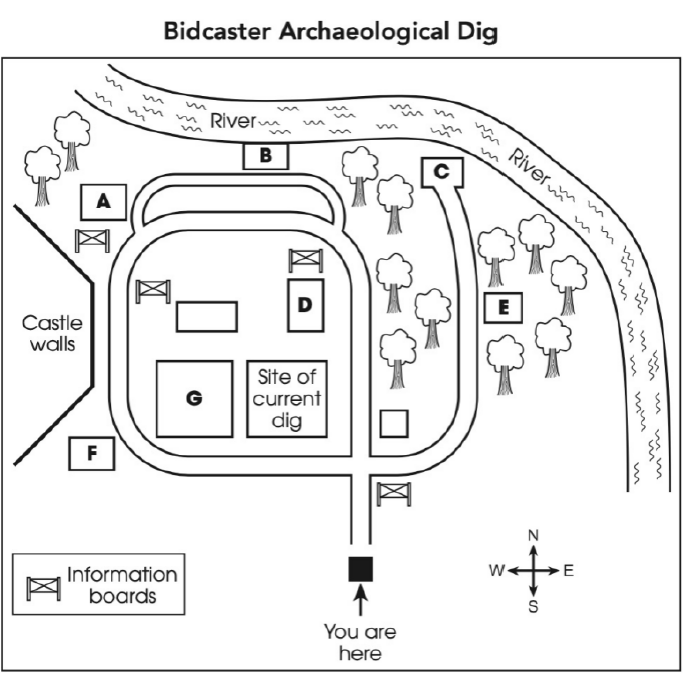Part 1: Questions 1-10
Complete the table below. Write ONE WORD AND/OR A NUMBER for each answer.
Furniture Rental Companies | ||
Furniture Rental Compainies | Information about costs | Additional notes |
Peak Rentals | Prices range from $105 to (1) $ ____ per room per month | The furniture is very (2) ________ Delivers in 1-2 days Special offer: Free (3) __________ with every living room set |
(4) __________ and Oliver | Mid-range prices 12% monthly fee for (5) ________ | Also offers a cleaning service |
Larch Furniture | Offers cheapest prices for renting furniture and (6) ________ items | Must have own (7) __________ Minimum contract length: six months |
(8) __________ Rentals | See the (9) ________ for the most up-to-date prices | (10) __________ are allowed within 7 days of delivery |
Part 2: Questions 11-20
Questions 11-16. Choose the correct letter A, B or C.
11. Who was responsible for starting the community project?
A. the castle owners
B. a national charity
C. the local council
12. How was the gold coin found?
A. Heavy rain had removed some of the soil.
B. The ground was dug up by wild rabbits.
C. A person with a metal detector searched the area.
13 What led the archaeologists to believe there was an ancient village on this site?
A. the lucky discovery of old records
B. the bases of several structures visible in the grass
C. the unusual stones found near the castle
14. What are the team still hoping to find?
A. everyday pottery
B. animal bones
C. pieces of jewellery
15. What was found on the other side of the river to the castle?
A. the remains of a large palace
B. the outline of fields
C. a number of small huts
16. What do the team plan to do after work ends this summer?
A. prepare a display for a museum
B. take part in a television programme
C. start to organise school visits
Questions 17-20. Label the map below.
Drag the correct letter, A-G, next to Questions 17-20.
17. bridge foundations ____
18. rubbish pit ____
19. meeting hall ____
20. fish pond ____

Part 3: Questions 21-30
Questions 21-26. Choose the correct letter, A, B or C.
21. Finn was pleased to discover that their topic
A. was not familiar to their module leader.
B. had not been chosen by other students.
C. did not prove to be difficult to research.
22. Maya says a mistaken belief about theatre programmes is that
A. theatres pay companies to produce them.
B. few theatre-goers buy them nowadays.
C. they contain far more adverts than previously.
23. Finn was surprised that, in early British theatre, programmes
A. were difficult for audiences to obtain.
B. were given out free of charge.
C. were seen as a kind of contract.
24. Maya feels their project should include an explanation of why companies of actors
A. promoted their own plays.
B. performed plays outdoors.
C. had to tour with their plays.
25. Finn and Maya both think that, compared to nineteenth-century programmes, those from the eighteenth century
A. were more original.
B. were more colourful.
C. were more informative.
26. Maya doesn’t fully understand why, in the twentieth century,
A. very few theatre programmes were printed in the USA.
B. British theatre programmes failed to develop for so long.
C. theatre programmes in Britain copied fashions from the USA.
Questions 27-30
What comment is made about the programme for each of the following shows?
Choose FOUR answers from the box and write the correct letter, A-F, next to Questions 27-30.
Show 27. Ruy Blas 28. Man of La Mancha 29. The Tragedy of Jane Shore 30. The Sailors’ Festival | Comments about programme A. Its origin is somewhat controversial. B. It is historically significant for a country. C. It was effective at attracting audiences. D. It is included in a recent project. E. It contains insights into the show. |
Part 4: Questions 31-40
Complete the notes below. Write ONE WORD ONLY for each answer.
Inclusive design
Definition:
Designing products that can be accessed by a diverse range of people without the need for any (31) ________
Not the same as universal design: that is design for everyone, including catering for people with (32) ________ problems
Examples of inclusive design
(33) __________ which are adjustable, avoiding back or neck problems
(34) __________ in public toilets which are easier to use
To assist the elderly:
– designers avoid using (35) __________ in interfaces
– people can make commands using a mouse, keyboard or their (36) __________
Impact of non-inclusive designs
Access
– Loss of independence for disabled people.
Safety
– Seatbelts are especially problematic for (37) __________ women.
– PPE jackets are often unsuitable because of the size of women’s (38) __________
– PPE for female (39) __________ officers dealing with emergencies is the worst.
Comfort in the workplace
– The (40) __________ in offices is often too low for women.
Answers
Test 3
1. 239|two hundred thirty-nine / two hundred and thirty-nine
2. modern
3. lamp
4. Aaron
5. damage
6. electronic
7. insurance
8. space / Space
9. app
10. exchanges
11.B
12.A
13.A
14. C
15. B
16. C
17. B
18. A
19. G
20. E
21. B
22. A
23. C
24. A
25. C
26. B
27. F
28. E
29. B
30. D
31. adaptation
32. cognitive
33. desks
34. taps
35. blue
36. voice
37. pregnant
38. shoulders
39. police
40. temperature